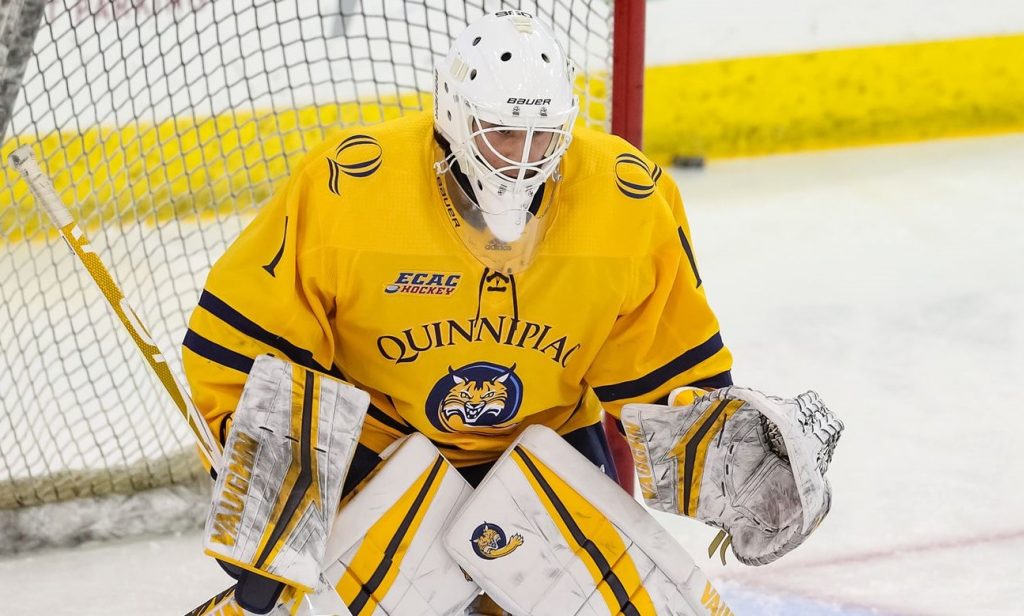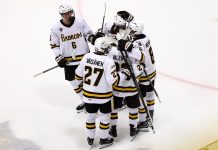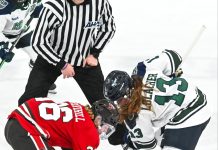
Each week during the season, we look at the big events and big games around Division I men’s college hockey in Tuesday Morning Quarterback.
Dan: Alright, we are back, and for a switch this week, we’re going to start rotating our four national writers to give everyone some debate among our pairings.
This week, I’m going to give it a go with Paula, which I’m hoping means I’m not participating in the CCHA drinking game that Ed Trefzger mentioned a few weeks ago. But since nobody can actually prove it….wink wink…
Anyway, we’re in full swing here now that the calendar is in November, and I’m finding myself falling into a weekly routine that starts when the most recent poll is released. I know the poll is more of a current state litmus test than it is a barometer for the end of the season, but it always provides a good foundation to transition out of last week and into the upcoming week.
Even though we’re still relatively early in the season, we’re starting to see some clear divides in the rankings with a tier of elite teams garnering the first place votes – St. Cloud led everyone with 42 votes and the No. 1 overall spot, but Michigan, Minnesota State and Minnesota-Duluth are all right in there.
There are two stray votes, though, for undefeated Harvard sitting at No. 10. Normally, I’d have a laugh like the time I voted for a team No. 1 overall two or three years ago and I was the only one who did (I think UMass might have been No. 1 with every vote except mine), but whenever I see a team buried that deep with first place votes, I wonder if someone knows something that we don’t.
So my question for you, Paula, is this, which is something I posed to Jimmy last week: are there other teams we’re just not talking about nearly enough? Specifically related to Harvard, the Crimson ran their season to 4-0 by sweeping Cornell and Colgate with another eight-goal breakout, and they’re currently outscoring teams by a 24-9 margin.
Paula: Dan, I’m going to take the Harvard-specific part of that question first.
I don’t know how to talk about a team that has played four games this season other than how we talked about every team four games into this campaign about a month ago. Harvard looks good. I’m not sure what else to say – nor do I think that’s being disrespectful in any way.
Add to this that the Ivies didn’t play last year, and – honestly – what are we supposed to say? We’re into the second month of a college hockey season that is attempting to reinvent something like normalcy after 1) a 2020-21 season that was anything but normal, and 2) a 2019-20 season that ended abruptly, and 3) a season-long absence for an entire subset of programs.
I’m not being flippant here. Ignoring how all of the peripheries affect our judgment seems dishonest – and those peripheries certainly play into the games as well.
Of course, the Ivies begin later than everyone else in any season, and that always impacts how they’re viewed by many people. It seems to me that we get a good read on Ivy League programs by January, and in the second half it’s easier to discuss relative strength.
As for Harvard, they’ve looked pretty strong in those four games. Yes, we should pay attention to that. We should notice how they came from behind against Cornell and never trailed Colgate. We should notice that two Crimson sophomores have five goals in four games. Yes, I have them at No. 10 in my ballot this week.
And – of course – there are programs we should notice and programs that we sometimes overlook. Ed and I talked about this a couple of weeks ago, how each of us has blind spots. Collectively, we are sometimes slow to trust some programs (why is Ohio State 18th?) and unwilling to give up on others (why is Denver 14th?), but I think it’s less about overlooking programs that maybe should get more attention than it is about not quite seeing as big a picture as we will in a few weeks.
St. Cloud, though, is an easy call for first place. The Huskies swept Colorado College on the road and extended their win streak to four games. I think the voters see St. Cloud as one of the most consistent teams, and one with a tough schedule.
There were several splits last weekend among top-10 teams and even teams that swept either were rebounding from a split weekend – like Michigan and North Dakota – or teams playing schedules that voters perceive as weaker, like Quinnipiac and Massachusetts.
For what it’s worth, Quinnipiac is one of my blind spots but the Bobcats’ five-game undefeated streak put them No. 3 on my ballot this week.
Dan: Both North Dakota and Quinnipiac are teams that I am trying to keep an eye on throughout this entire season.
The Fighting Hawks made quick work of Denver this weekend with a 7-2 rout over the two nights, and the Bobcats shutout both Yale and Brown. The Brown game in particular was something to watch because the Bobcats kept chipping away. They were gifted six different power plays by the Bears, and the fourth one in the third period was ultimately the one that provided a breakthrough. Like you, I had Quinnipiac at No. 3 this week as other teams slid down the rankings.
For what it’s worth, Quinnipiac triggered a number of conversations for me.
My broadcast partner at Bentley, Matty O’Brien, introduced me to a couple of different terms and formations this weekend on special teams, and we wound up talking about assistant coaches who work on the power play and penalty kill units and how some of them truly have to grind away in practice. Every player has to cover a certain amount of space and ground on both the power play and the kill, and there are a number of teams who consistently succeed thanks to the system.
In our case, Bentley historically has been one of those teams in Atlantic Hockey, and we still kind of recognize the system for how it rolled forward as players swapped in and out. Even in down years, that reputation feels like it exists every time the team steps out for another power play.
It’s something that fascinated me, and it opened a bigger look at which teams are usually very good on special teams. I discovered the correlations between teams like Notre Dame, Quinnipiac and Clarkson, for example, who are all elite penalty kill teams. As the year goes on, I’m curious if those trends will continue and if we think the teams that are able to maintain elite level, situational hockey will be able to win those games that matter the most when things really heat up.
Paula: That is a really great observation, Dan, about situational hockey. It’s more than just what some coaches like to call “the specialty teams” – a phrase that tickles me because it sounds like a menu item at a really exclusive restaurant. There are ways certain teams have of honing in on system strengths as well as the sum of the talents and strengths of the guys on the current roster.
You mention Notre Dame, which is another blind spot team for me. I have enormous faith in Notre Dame’s coaching staff and there’s no question that Notre Dame is a program that develops talent as well. One of the perennial complaints about the Fighting Irish is that they can be a boring, defensive team, and yet Jeff Jackson’s defense-first philosophy has taken Notre Dame to 11 NCAA tournaments, four Frozen Fours and two national championship games, and under Jackson, the Irish have won their conference playoff championships five times (in two different conferences). Penalty killing is a big part of that, but it’s a defense-first mentality.
I look at Michigan, which has the third-best power play in the country and eighth-best offense currently and I think less about special teams than I do about speed. That’s their ticket – that and a boatload of talent that is learning how to click, of course.
Something I don’t think we’ve talked about here a whole lot is the push in sports to consider analytics. It’s become so big in the NHL, so regularly discussed that I think it’s taken for granted that team are using on-ice analytics to shape strategies.
I wonder, though, how much data-driven analytics can affect the college game, sustained over years and years. Obviously, each team uses data to drive many aspects of play, and maybe in college hockey “analytics” is a new way of saying what so many coaches tell media: “We’re just focusing on ourselves and not our opponent.”
Have you heard anything in your neck of the hockey woods about this sports buzzword? How much do you think the concept itself may already be part of college hockey? Do you think that specific data vs. trends (or along with overall trends) will be something that emerges in college hockey in the future?
Dan: It’s kind of interesting.
I wish I could sit back and talk about analytics like I know something about them, but I truthfully haven’t had too many discussions about the advanced statistical side of the game. I know they’re there, and it doesn’t take a stop at a coach’s box or table to know there are staff members hired to record every clickable event on the ice over the course of the game.
During broadcasts on television, I’m seeing more and more numbers, including offensive zone entry times and unblocked shot attempts, all of which are numbers we didn’t really consume or consider when I was growing up and scoring goals off one-timers in NHL ’93 with Jeremy Roenick.
For what it’s worth, I am a little bit of a grumpy old man when it comes to analytics in hockey. I love statistics, and they make my job as a writer much easier to prove how a team is better or worse than another team. As a baseball guy, I’m very in tune with how numbers are advancing, and I’m infatuated with them across the board. But as a hockey writer and follower, I prefer to watch the game from a more romantic point of view. I don’t think we need a fancy number to determine if a team is overpowering its opponent if the lines are changing uncontested during a shift that stays inside the offensive zone.
We likewise don’t necessarily need the number to show us how they maintain possession if they’re constantly winning offensive zone faceoffs. I would like to see more numbers available about matchups and which players do well against another; I think specifically about a situation during the ECAC playoffs where I started tracking one team’s substitution habits on faceoffs whenever its opponent sent a particular line out on the ice. It became evident very quickly how there was an advantage with one player in the circle over another, and that team was able to dictate pace whenever they won those faceoffs.
I do think analytics are growing, and I am very much in favor of their use if they can prove different areas to me. I just think that numbers, even though I love them, are admittedly malleable and bendable to tell whichever story we want. I dislike CORSI, but I like Pythagorean win-loss records and expected goals (both of which I know from baseball). I don’t totally understand PDO, which is shooting plus save percentage to determine if a team’s lucky or not, since I think there are some other factors that the numbers don’t take into consideration – namely if the shot came in because there was a player boxed out on the wing, etc.
I know that’s a roundabout way of saying I both like and dislike numbers, and you’ve given me reason to talk to coaches about how they employ them. As we evolve, so too will the game. After all, I don’t think teams are rolling old school fourth line checking lines like they used to.
One thing I will agree and probably enjoy is the presence of specialized players as a result of the numbers. We used to say a player was a puck-moving defenseman or a stay-at-home guy, and we used to have fast guys and thumpers or enforcers. I feel like all of those nicknames are changing. Do you think we can find those through analytics, and more importantly, how does the college game continue to evolve as those players make their way through the pro ranks?
Paula: It’s funny that you mention being something of a grumpy old man because I was thinking as I wrote that last section about how I can typify the old guy (or gal) shaking a fist at clouds or screaming, “Get off my lawn!” when it comes to many things, analytics included.
I’m no expert on analytics by any stretch, but I am in favor of using every bit of information available to us to analyze the game we love. I am sure that coaches are open to every new tool that comes their way – and why wouldn’t they be?
That having been said, there’s no question that sports for me are about the humans that play them and coach them, the humans root for their teams, the humans that cover the play, the business, the culture of sports. Without that human connection, college hockey means nothing to me.
I don’t know what analytics or the next trend in data-driven introspection will reveal, but I do think that the culture of hockey is changing in significant ways and in a very short period of time, relatively speaking. We may not value the enforcer so much – or we may not be comfortable saying that we do – but I’m sure that new roles will emerge as we continue forward.
This younger generation of professional players is redefining hockey culture, whether they’ve played in the college ranks or not. To answer your question directly, yes I do think that analytics and other developments will change how we see specialization of roles in hockey, but even more so, I think we’ll see an evolution of the on-ice game as off-ice culture continues to change.


